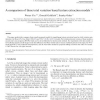Free Online Productivity Tools
i2Speak
i2Symbol
i2OCR
iTex2Img
iWeb2Print
iWeb2Shot
i2Type
iPdf2Split
iPdf2Merge
i2Bopomofo
i2Arabic
i2Style
i2Image
i2PDF
iLatex2Rtf
Sci2ools
98
Voted
JVCIR
2007
2007
A comparison of three total variation based texture extraction models
This paper qualitatively compares three recently proposed models for signal/image texture extraction based on total variation minimization: the Meyer [27], Vese–Osher (VO) [35], and TV-L1 [12,38,2–4,29–31] models. We formulate discrete versions of these models as second-order cone programs (SOCPs) which can be solved efficiently by interior-point methods. Our experiments with these models on 1D oscillating signals and 2D images reveal their differences: the Meyer model tends to extract oscillation patterns in the input, the TV-L1 model performs a strict multiscale decomposition, and the Vese–Osher model has properties falling in between the other two models. Ó 2007 Elsevier Inc. All rights reserved.
Related Content
| Added | 16 Dec 2010 |
| Updated | 16 Dec 2010 |
| Type | Journal |
| Year | 2007 |
| Where | JVCIR |
| Authors | Wotao Yin, Donald Goldfarb, Stanley Osher |
Comments (0)

